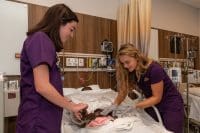Of the five Magnet® model components, the
shared governance (SG) process most closely
aligns with exemplary professional practice
and structural empowerment. A strong culture of
accountability and governance is crucial to demonstrating
sources of evidence within these components.
In many Magnet facilities, such as Morristown
Medical Center (MMC) in Morristown, New
Jersey, SG is an integral part of nursing professional
practice.
How shared governance evolved
From MMC’s introduction to SG beginning in 1988-89, direct-care nurses were involved in developing,
implementing, and evaluating the SG model. In
1991, an SG coordinating committee was formed to
work on implementing an SG model with Tim
Porter-O’Grady, DM, EdD, ScD(h), FAAN, a nurse
leader well known for his work on the subject. The
committee chose the councilor model, which uses
department- or unit-level councils to coordinate clinical
and administrative activities. This committee
was renamed the SG coordinating council and the
chair was an elected staff nurse. Under this model,
five councils were formed: coordinating, practice, education,
management, and quality improvement.
The role of the coordinating council was to promote
the implementation process with each council. Managers
already were holding monthly meetings, so
the patient-care management council became the
first to reorganize under the SG format. Consisting
of 70% staff nurses, the coordinating council set the
timeline for creating these additional councils. The
practice council was the next council to be formed.
Evaluation of nursing committees
The SG coordinating council reviewed all nursing
committees and evaluated the purpose, productivity,
and goals of each one. Each committee was either
assigned to one of the councils or eliminated.
Interdepartmental committees that interfaced with
nursing also were evaluated to determine their
nursing membership, participation, and a communication
mechanism and linkage to an appropriate
council. Bylaws were written and served as guidelines
for bylaw development by all other councils.
Once hospital-wide SG councils were formed and
goals were developed, they began operating. SG coordinating-
councilmembers promoted the education
and development of unit-based SG on patient-care
units. By the end of 1991, the coordinating council
transitioned to the SG executive council. SG then expanded
to other units and departments that employed
nurses. As early as 1995, councils included other disciplines
in theirmembership. Today, SG has been implemented
in other departments as well. Pharmacy, dietary,
and respiratory care staff continue to serve on
themain councils. (See Unit-based councils by clicking the PDF icon above.)
Nurses serve as representatives of clusters (service
lines) on a hospital-wide council for 18-month
terms, representing nurses from areas within their
clusters. At the start of their terms, new members
agree to abide by SG council bylaws, are oriented
to the process, and familiarize themselves with
council goals.
Hospital-wide SG councils include those on practice,
professional development, quality improvement,
nursing research, and patient-care management.
The coordinating council became the
executive council. Council chairs make up the executive
council. Other executive council members include
the director of quality and outcomes, the
manager of SG/Magnet and nursing education,
council manager-advisors, and the
chair (MMC’s chief nursing officer).
Using Magnet standards as a framework
As a Magnet hospital, MMC promotes
quality in an environment that supports
an accountability-driven model through
SG. Our culture of excellence in delivering
services shows how nurses respond
to the needs of patients and families.
MMC values nurses’ contributions and
seeks their input in administrative and
patient care-decisions through its SG
structure. The chief nursing officer and
other nursing leaders promote and expect the best in
nursing practice. This commitment to nursing helped
MMC achieve designation as a Magnet organization
with redesignations in 2005 and 2009.
SG executive council members and chairs of each
council’s committees meet at the beginning of the
year at the SG annual retreat to present goals, objectives,
and action plans for the coming year. Goals
for the next year are aligned with the strategies of
MMC and the nursing department. For organizations
applying for Magnet redesignation, more emphasis
is placed on demonstrating excellence
through quality outcomes and innovative practice.
At the annual retreat, SG goals are reviewed and related
to a Magnet source of evidence.
At the end of the year, councils and committees
evaluate their annual achievements and report
them to the SG executive council and patient-care
management council. Such coordination and communication
are essential to ensuring accountability
and achieving annual goals. Council and committee
chairs assess monthly progress throughout the
year and report to the patient-care management
council twice a year.
Evolution of SG councils
The SG practice council approves nursing practice
policies and procedures and ensures these reflect current
evidence-based practice. It evaluates and speaks
on behalf of staff regarding the impact and outcomes
of proposed policies and revisions, as well as
the effects of new products. The council also recommends
areas for nursing, patient, and family education.
Changes in strategies and direction are based
on results of the council’s evaluation and investigation.
The council speaks on the staff’s behalf, recommending
practice methods that reflect best practices.
The professional development council is responsible
for all nursing competencies and MMC’s clinical
ladder (the hospital’s nursing professional advancement
career track, or PACT). PACT program
criteria align specifically with the Magnet Recognition
Program® sources of evidence.
The quality council evaluates quality outcomes
of its committees, as well as action reports submitted
by specific areas. It oversees hospital-wide
nurse-driven data collection, reviews corrective action
related to quality improvement (QI) initiatives,
and collaborates on and supports nursing research
related to QI. It also defines the clinical peer review
process to foster professional growth and development.
The council chair is a voting member of
MMC’s quality and patient safety committee; this
provides a valuable opportunity for a staff nurse to
gain leadership skills by participating on a committee
with key organization leaders.
The patient-care management council supports
MMC’s annual goals through five committees: materials,
support, systems, human resources, and fiscal.
These committees represent the responsibilities
of managers within a SG professional practice
model. Manager members represent all units and
departments with direct or indirect responsibility
for patient care. The work of the patient care management
council is accomplished within these
committees.
A nurse researcher with a PhD permanently
cochairs the nursing research council along with a
staff nurse or clinical leader. The council’s goals
align with Magnet sources of evidence.
Improving patient outcomes
SG has influenced nursing practice at MMC by
transferring clinical nursing decisions from nursing
management to the professional bedside staff
nurse. This gives direct-care nurses greater opportunities
and fosters accountability and autonomy in
delivering safe, efficient and effective care.
Selected references
*****Visit www.AmericanNurseToday.com/Archives.aspx for a list of selected
references.****
Wendy J. Silverstein is the nursemanager for Shared Governance,Magnet, and Nursing
Education atMorristownMedical Center (MCC) inMorristown, NewJersey. The author
would like to thank Trish O’Keefe,MSN, RN, NE-BC, CNO, and Gloria Chappelle, RN, an
early leader in shared governance atMMC, for their contributions to this article.


















